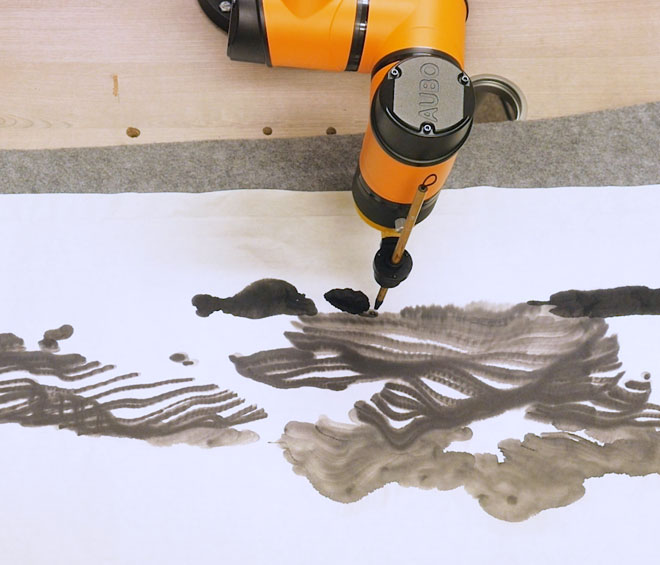
AI Gemini in action. Copyright Victor Wong.
by EMILY SPICER
There are two parts to AI Gemini, the artist and inventor Victor Wong (b1967, Hong Kong) tells me at 3812 London Gallery, “the brain and the arm”. AI Gemini, or simply Gemini, as Wong calls him, is a first, an AI robot-cum-artist three years in the making, trained, as it were, to paint landscapes in the Chinese tradition. Not even Wong knows exactly what his protege will produce. “You have to guess,” he says, comparing his invention to a black box – in computing terms, a device the internal workings of which are unknown. “I let him just paint it out.”
Gemini’s paintings, which are made with an ink-loaded brush held by a robotic arm, are pleasing to look at. The landscapes are sometimes watery and pale, sometimes described by tight, dark contours. Some look as though they could be the work of a human hand, others appear to be the product of a digital “mind”.
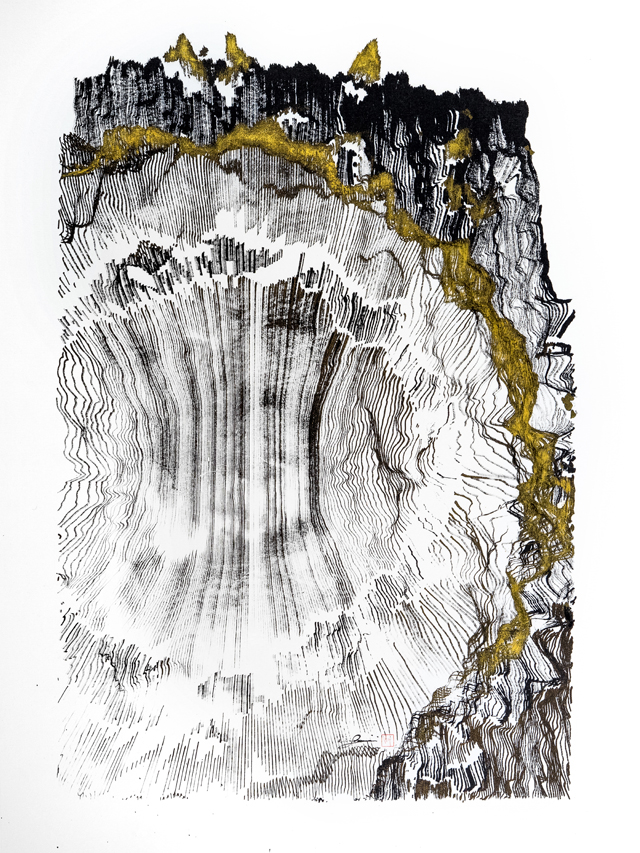
Victor Wong. Far Side Of The Moon 0001, A.I, 2019. Ink on paper, 89 x 62 cm. Copyright Victor Wong.
When I meet Wong, his exhibition Far Side of the Moon has just opened. Half of the images are what he calls “escapisms”, rocky landscapes made by Gemini in the Chinese tradition. The other works on display were made using data from China’s Chang-e 4 mission, the first to land on the “dark” side of the moon, the side we never see from Earth. Wong took this information, together with 3D observations taken by Nasa, and fed it to Gemini, not knowing what it would produce. The results vary. Some images resemble craters, others look like imagined fantasy landscapes, drawn by a confident hand.
For one lunar painting, Wong gave Gemini gold ink to add to the black, and the outcome was really quite extraordinary. The AI artist added the new pigment in a very particular way, colouring the edge of a crater, giving the impression of a fiery corona. It really does seem as though this artificial artist, this machine that learns, made a deliberate, and good, aesthetic decision. I asked Wong what he felt about this possibility and how he hopes Gemini will develop.
Emily Spicer: Does Gemini have any sense of what looks good, any sense of aesthetics?
Victor Wong: Yes, like us. We have a left brain and a right brain and so does Gemini. It generates the landscape on some preset factors and also some geographical parameters using real-time data such as humidity and temperature. Every time he draws, he’s affected by the weather. On rainy days, he uses more water. Like us; we’re affected by our surroundings.
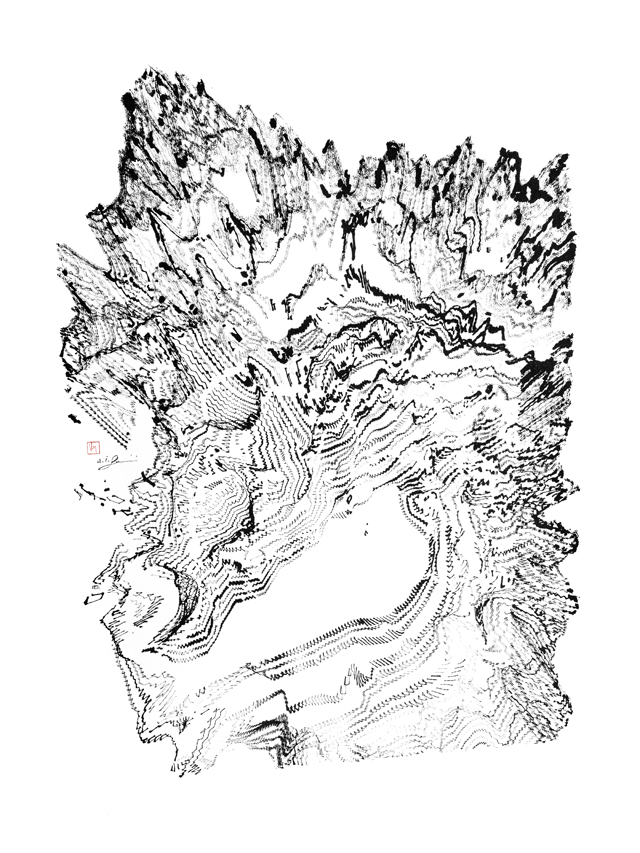
Victor Wong. Far Side Of The Moon 0003, A.I, 2019. Ink on paper, 89 x 62 cm. Copyright Victor Wong.
ES: Where is he getting the information about the weather?
VW: He’s connected to the internet, and checks the data from the observation centre.
ES: He is checking the weather and then he is feeding that information into his artwork.
VW: That is what we call real-time variables. On rainy days, we feel blue, and on sunny days, like today, we feel better! I would say that it is emotional emulation. We learn from experience, we learn from our surroundings and Gemini learns the way we learn. And nowadays we learn from cell phones, we learn from the internet. That is what I want him to do. After two years of development, it’s not just a tool for me, it’s a companion, a creative partner. I cannot draw by myself! [laughs]
ES: So you are collaborating with him, but these images are his own work?
VW: Yes, but I give him some advice on creating landscapes and on the view. I teach him the basic techniques of photography. If you frame something, like a medium shot, or a portrait, Gemini knows what this means. Everything can be converted to data that AI understands.
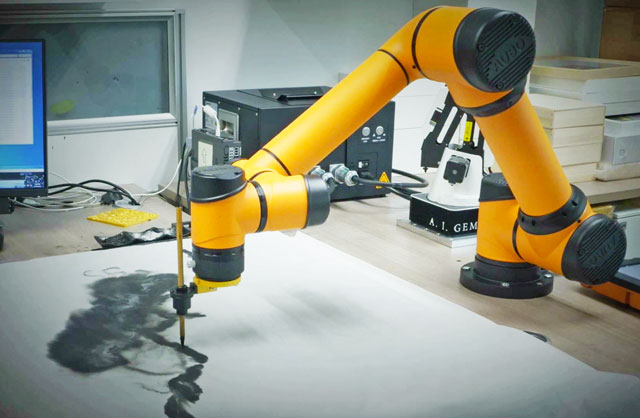
AI Gemini in action. Copyright Victor Wong.
ES: Do you have a background in programming?
VW: I programmed it with my team. My background is in engineering. I studied engineering at the University of Washington and then worked in the movie and advertising business for three decades. I was using computer graphics all the time, so naturally I used the computer as a tool. But AI is not just a tool. If you give him something, he will inspire you. The human is inspired by the machine and the machine is modified by the human. It’s a cycle.
When I was small, my father ran a shop selling Chinese art, so I was exposed to paintings, and, as I say, I worked in the computer graphics industry for 30 years, so naturally I put the two together, because it’s something I am familiar with. Then I asked the question, what topic should I draw? Landscape painting is a big part of painting in our culture because in the past it was used as a narrative tool and that’s how our ancestors praised how great nature is. But how to draw it?
I read some articles about AI and feeding in, say 1,000 pictures, which it analyses to give you one, or 10, and you can pick one. I didn’t think that was something I wanted to do because I wanted Gemini to start doing new things. So, first, I taught Gemini how to use a brush, to dip it in water and ink, to make grey lines and dots. These are the basic building blocks, and those teachings are put into the database. And then the picture. I do not want him to copy from the masters, because I want him do something unique, so I go back to the fundamental things, how landscape is made by mountains, rain, wind, erosion and terrain formations.
You can reveal these things using equations, which I feed to him, so he can create his own world. We Chinese, we do not draw from life much, we go travelling and we come back to the studio or in front of our father, mother, grandfather and say, OK, I saw something like this! There is a mountain and I saw an old man there. That is something that we did in ancient times, we created our pictures based on what we saw, which we then interpret into painting. So Gemini creates a mindscape using the data from reality.
ES: How does he develop his art?
VW: The first few pieces were similar, using a dry brush, which is why I hooked him up to the internet to get some real time variables such as temperature and humidity. Maybe in the future, I will hook him up to voice and then, after you’ve yelled at him for 20 minutes, he might do something crazy! [laughs]
ES: So you want him to respond to your mood as well? To reflect how he has been spoken to?
VW: I think so. Just like us. We are programmed by our experience. We are programmed by our surroundings. We are programmed by how we grow up. If we grow up in a tunnel and never see a tree, we do not have the information to imagine a landscape because we only see darkness.
ES: How do you feel about Gemini? Do you feel an emotional attachment to him?
VW: Right now, I feel that he is my creative companion. I could not create these pictures by myself, without Gemini.
ES: I know this is philosophical territory, but do you think AI will one day have the ability to become sentient?
VW: That’s a good question because humans’ minds are so contradictory sometimes. We create AI so we can create something that can do without emotions. You can skip out the emotions and extract data. But on the other hand, we want AI to respond to us emotionally. That’s contradictory, right? I think that development is ongoing. It’s going to take less and less time for [AI] to respond, and that makes us fear that the machine is very closely human because it reacts like us. That is something that is going to happen. For me, that’s good because I can do more experiments [laughs].
I want to show Gemini a piece of video, and then go: “OK, digest it, give me something else.” It’s what kids do. Take kids to a movie and say: “OK, can you draw pictures of what you saw? Or can you draw a picture of what you are feeling?” That response is what I want from Gemini in the future.
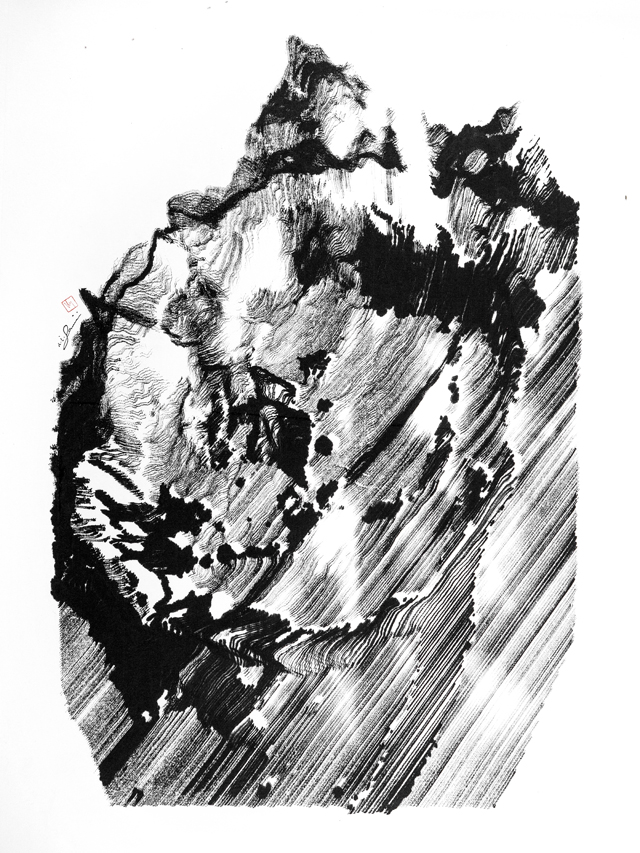
Victor Wong. Far Side Of The Moon 0006, A.I, 2019. Ink on paper, 89 x 62 cm. Copyright Victor Wong.
ES: Tell me about Gemini’s paintings of the far side of the moon.
VW: In January, China put a probe on the far side of the moon. There is some observation data from Nasa, too, but Chang-e 4 was the first to land there. They found that the far side has more craters and also a thicker crust. It’s easy for AI to copy a picture, black and white and black and white, just like a scan, but I want Gemini to interpret the data, to form his own moonscape.
And look at that, how he uses the brush. It’s not like the fountain pen with just one intensity because the brush is soft. The topics, the style, the way he draws is different from the Chinese painting, but the spirit, the looking, and how the ink reacts to the paper is so Chinese.
ES: Is this your signature?
VW: This is his signature and I write the “AI” before it because I created him [laughs].
• Victor Wong X AI Gemini: Far Side of the Moon is at 3812 London until 11 May 2019.